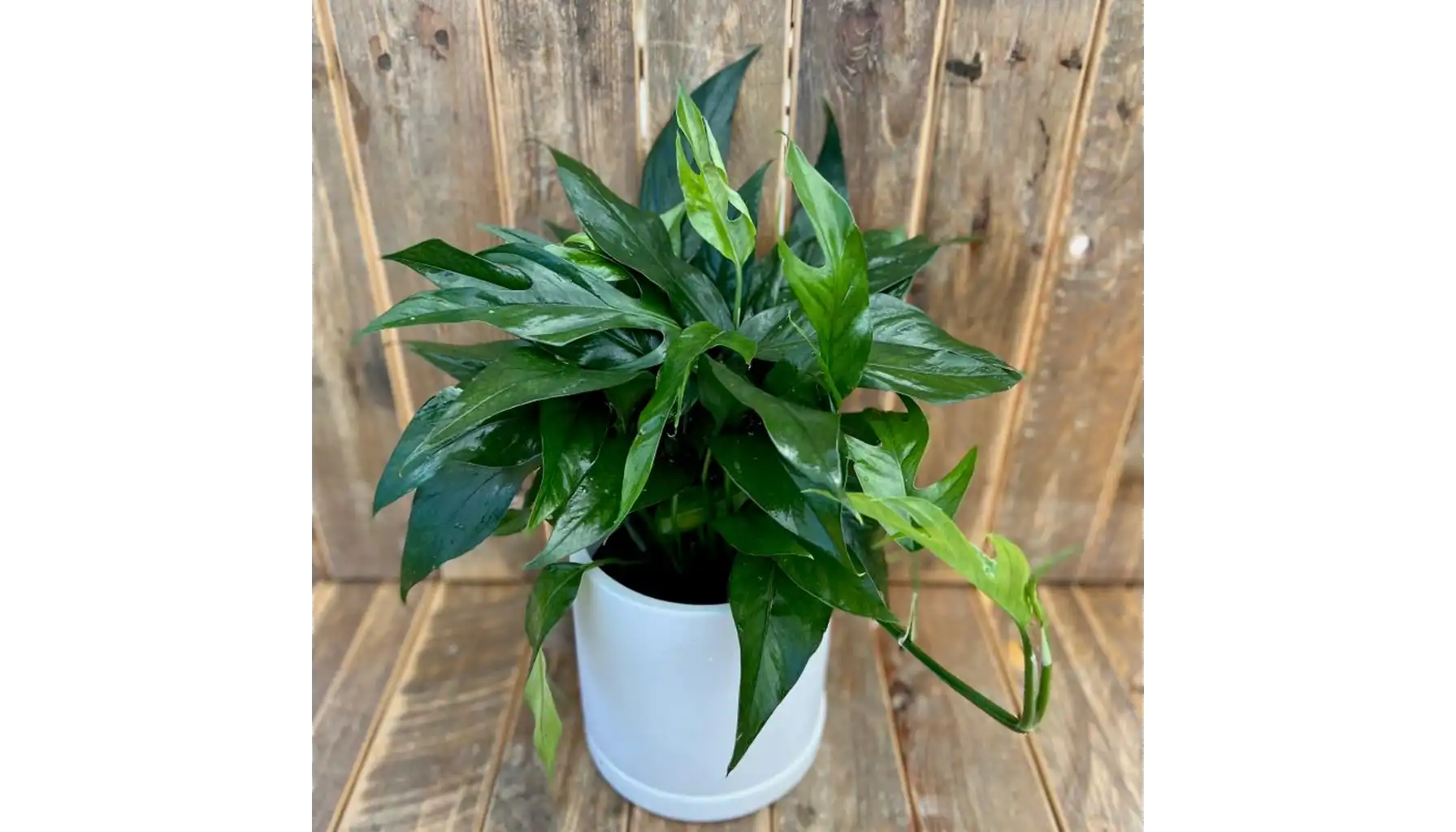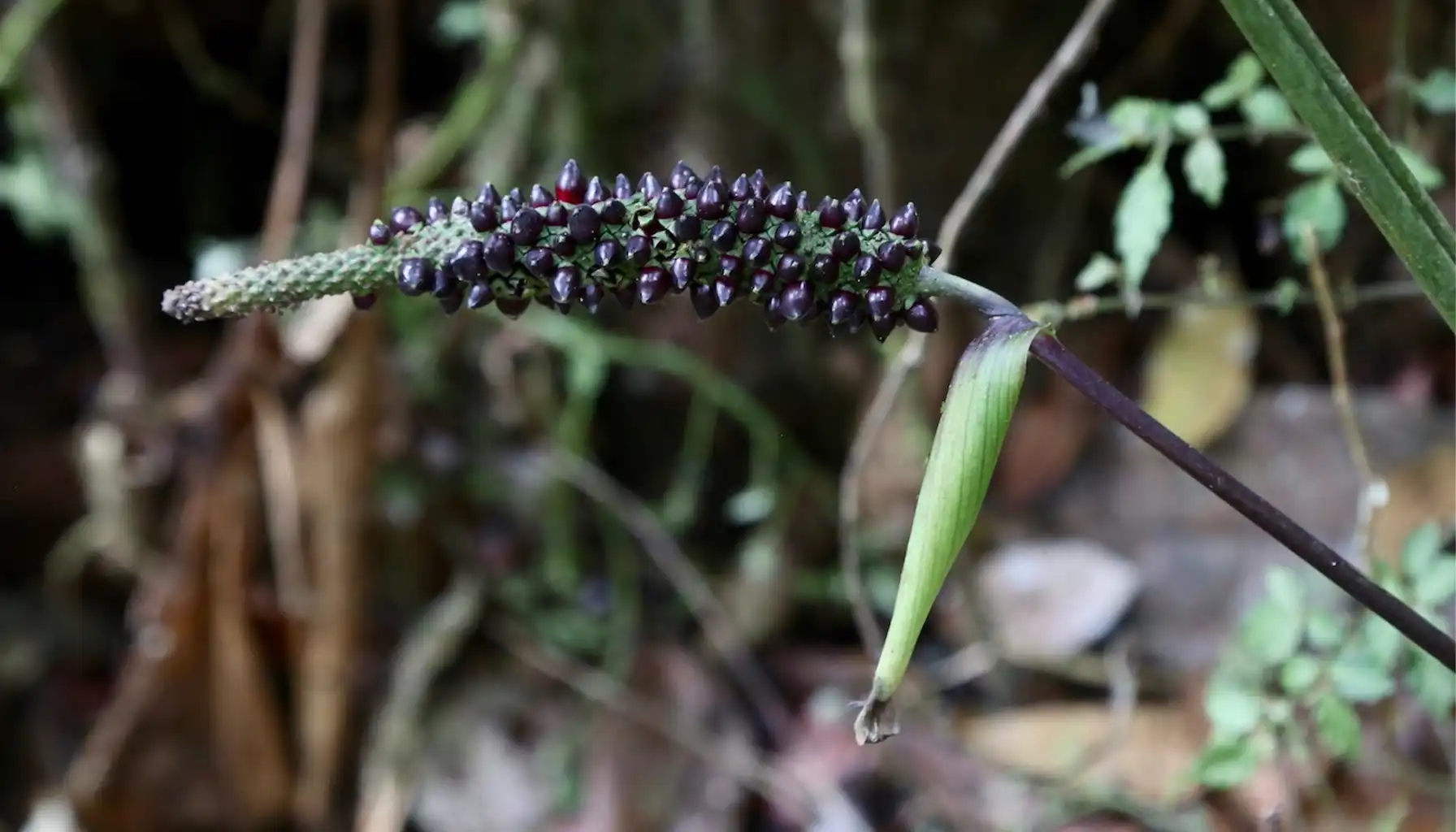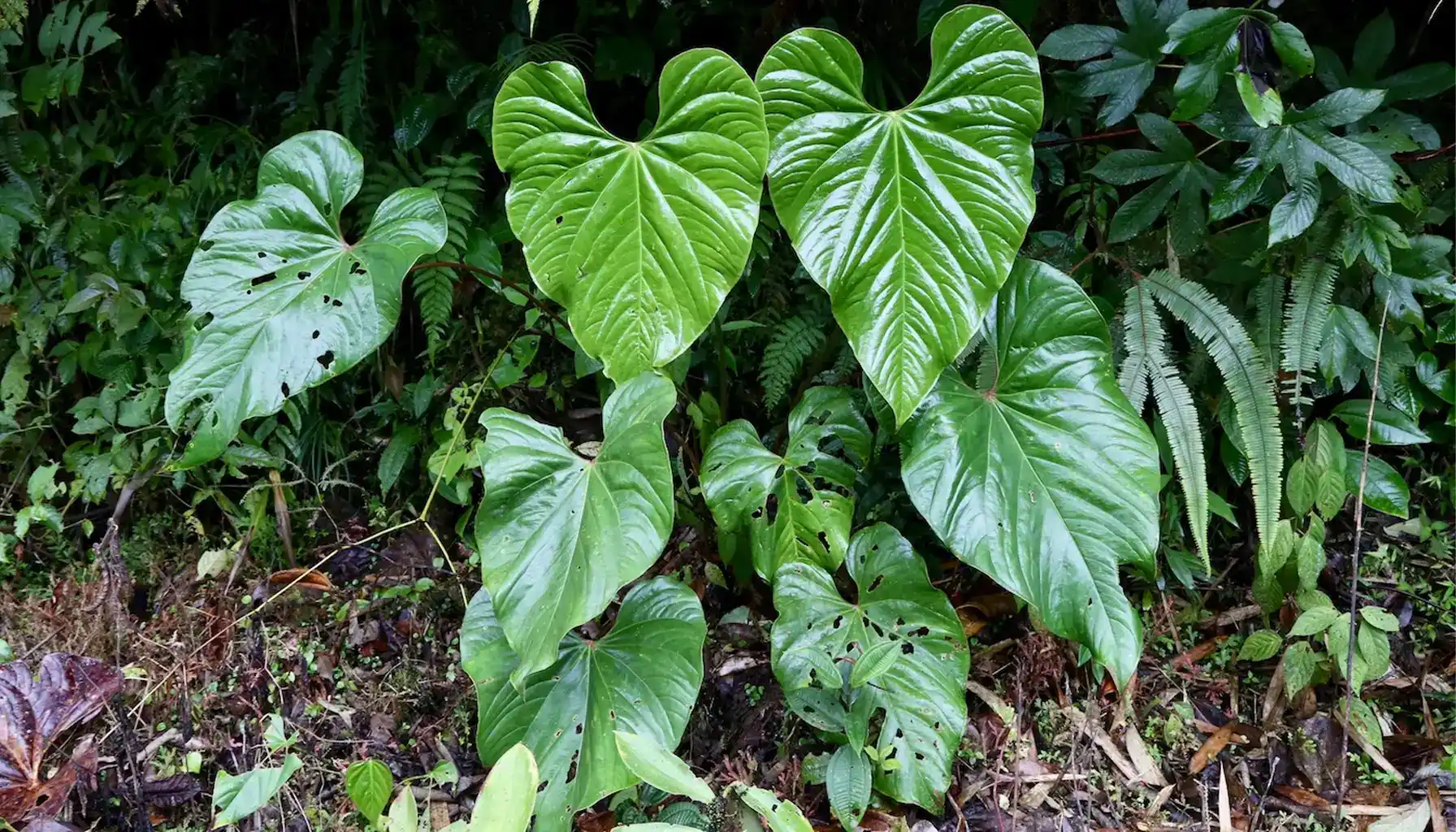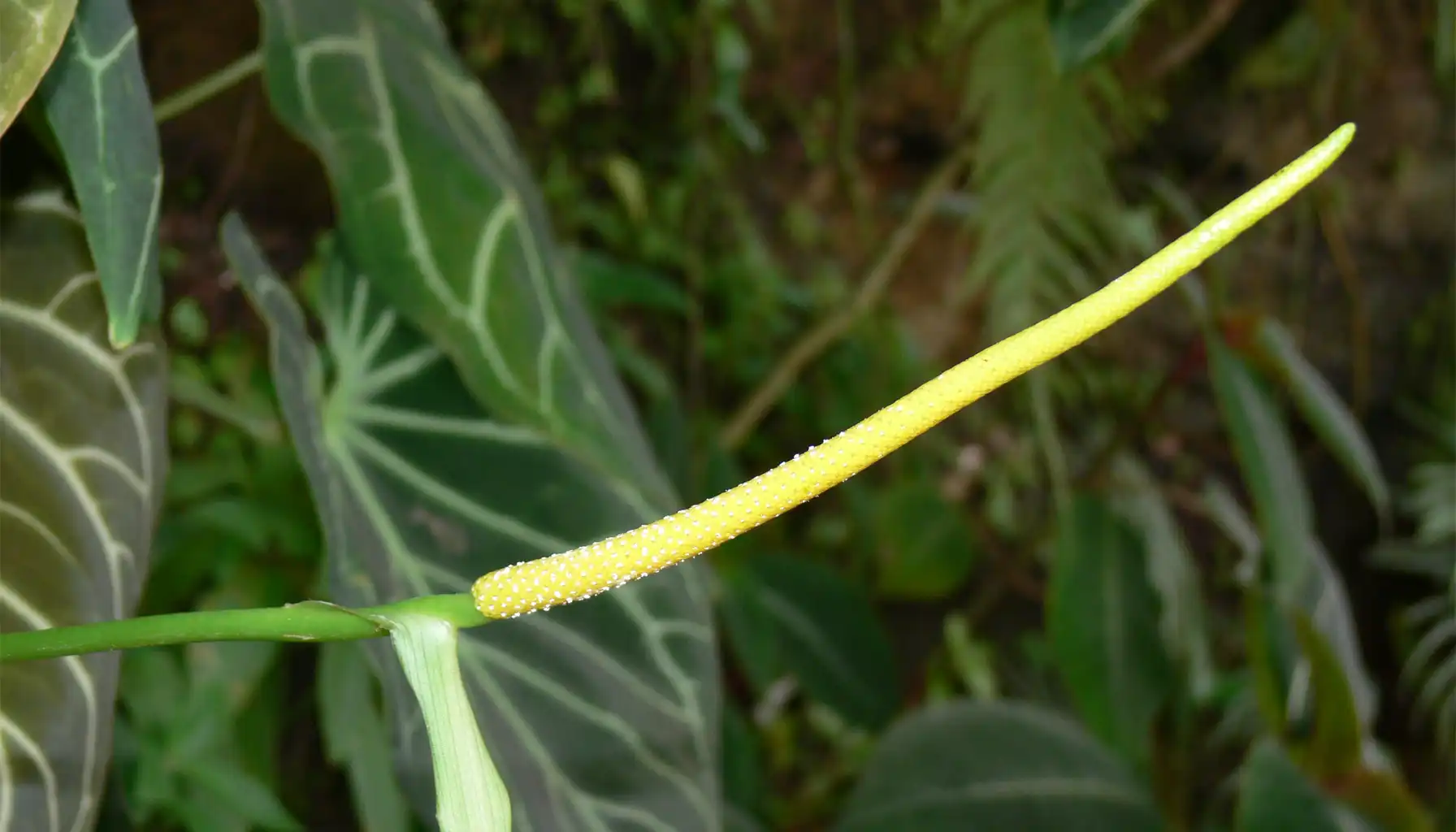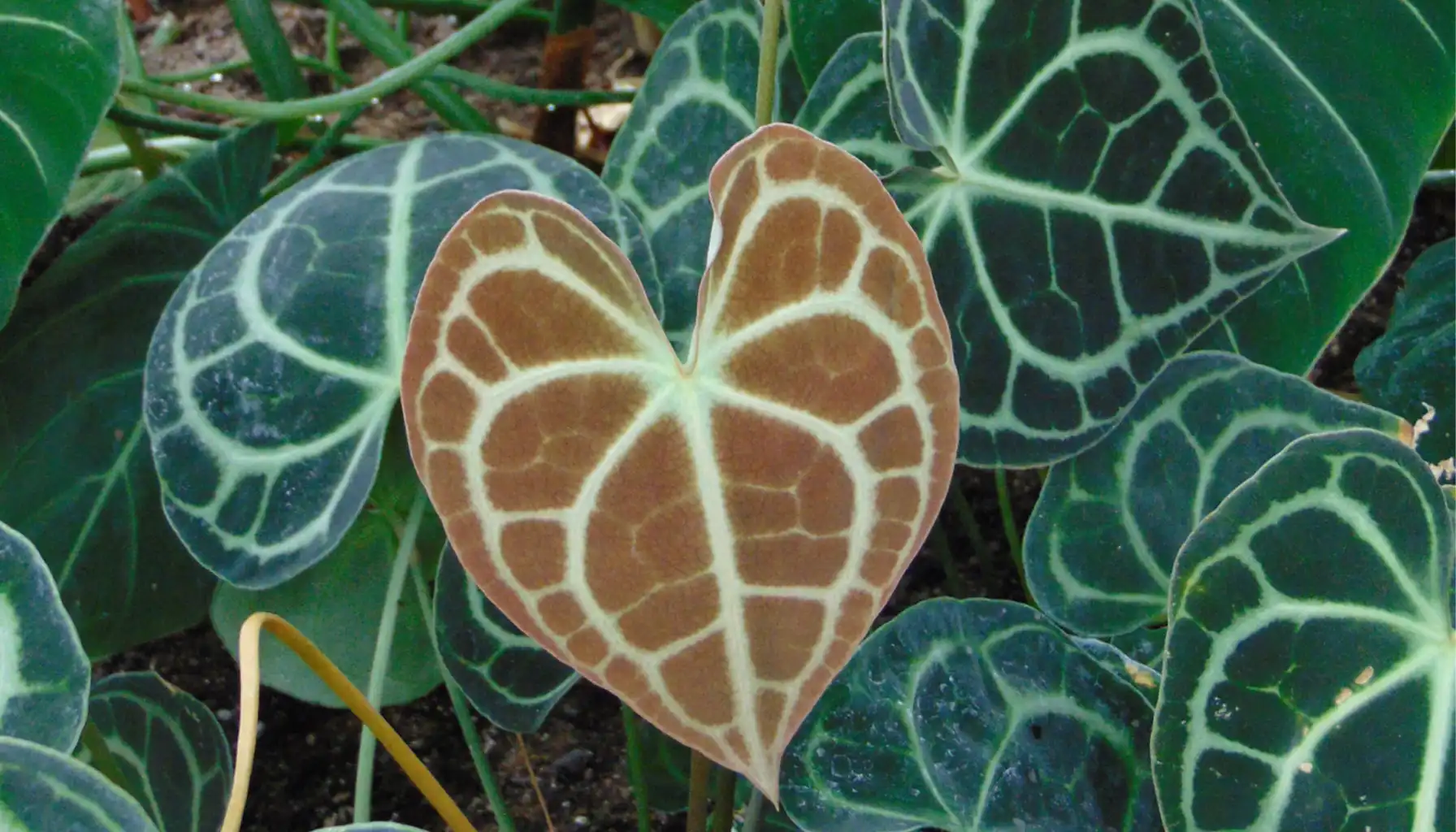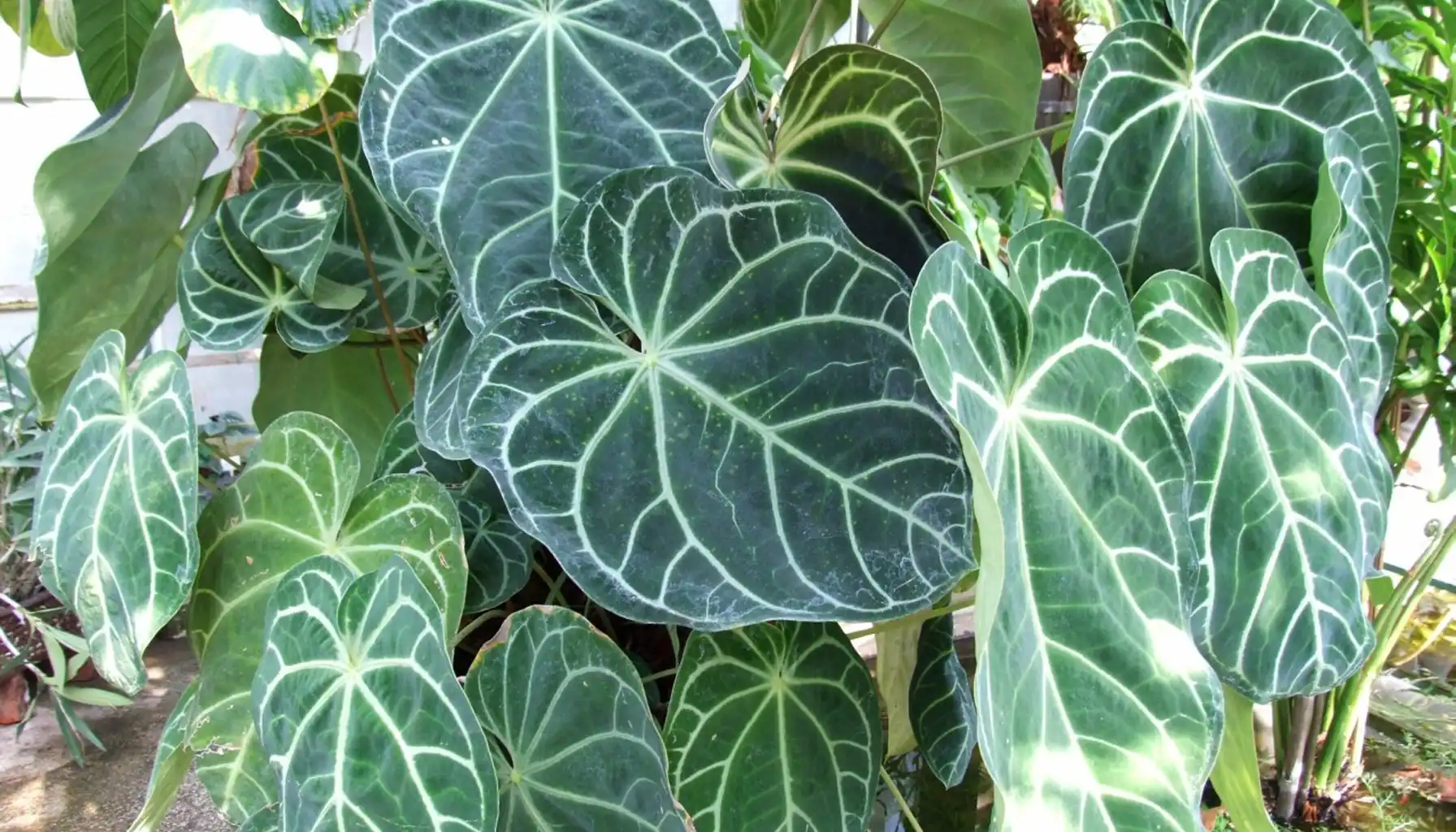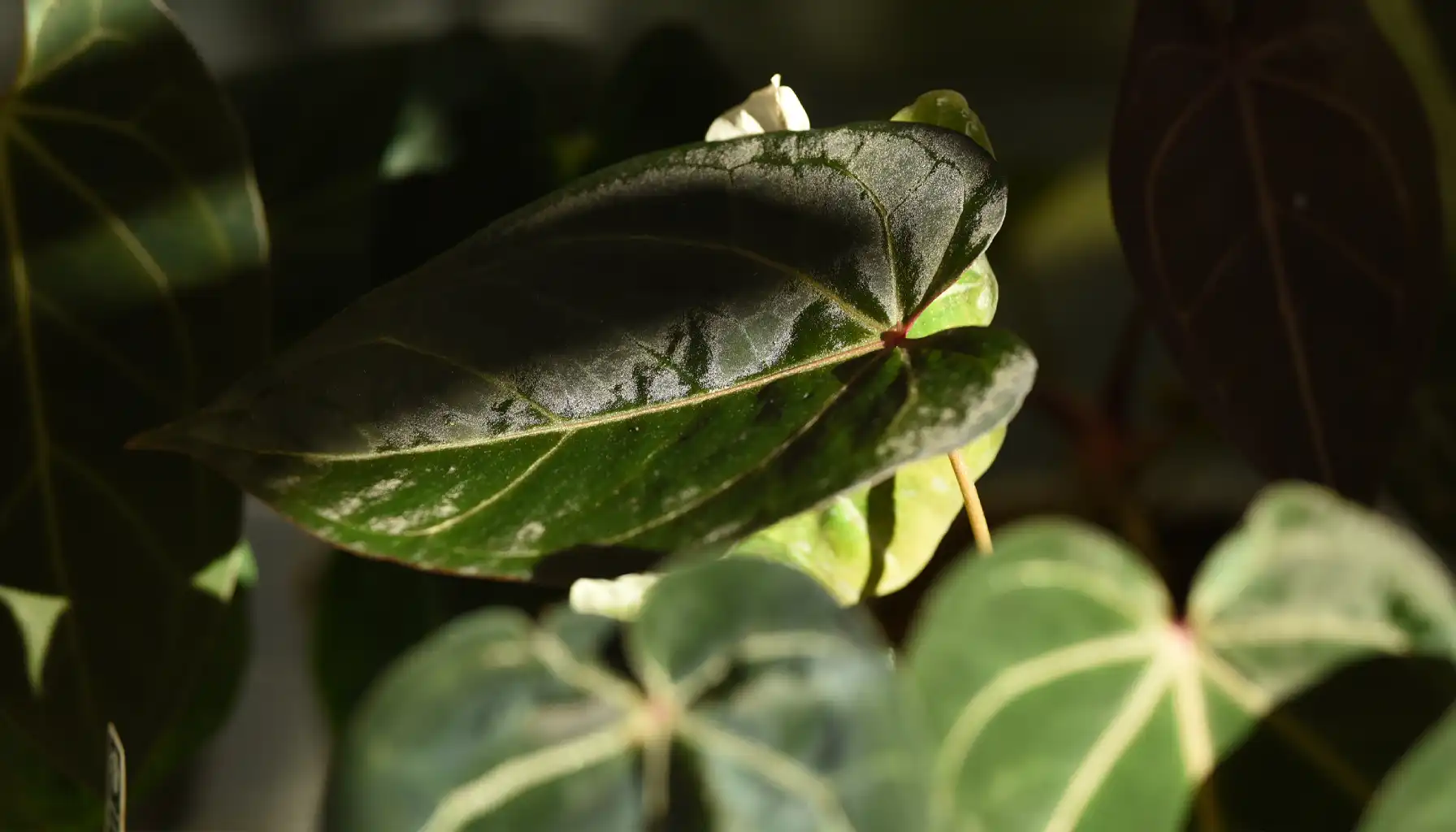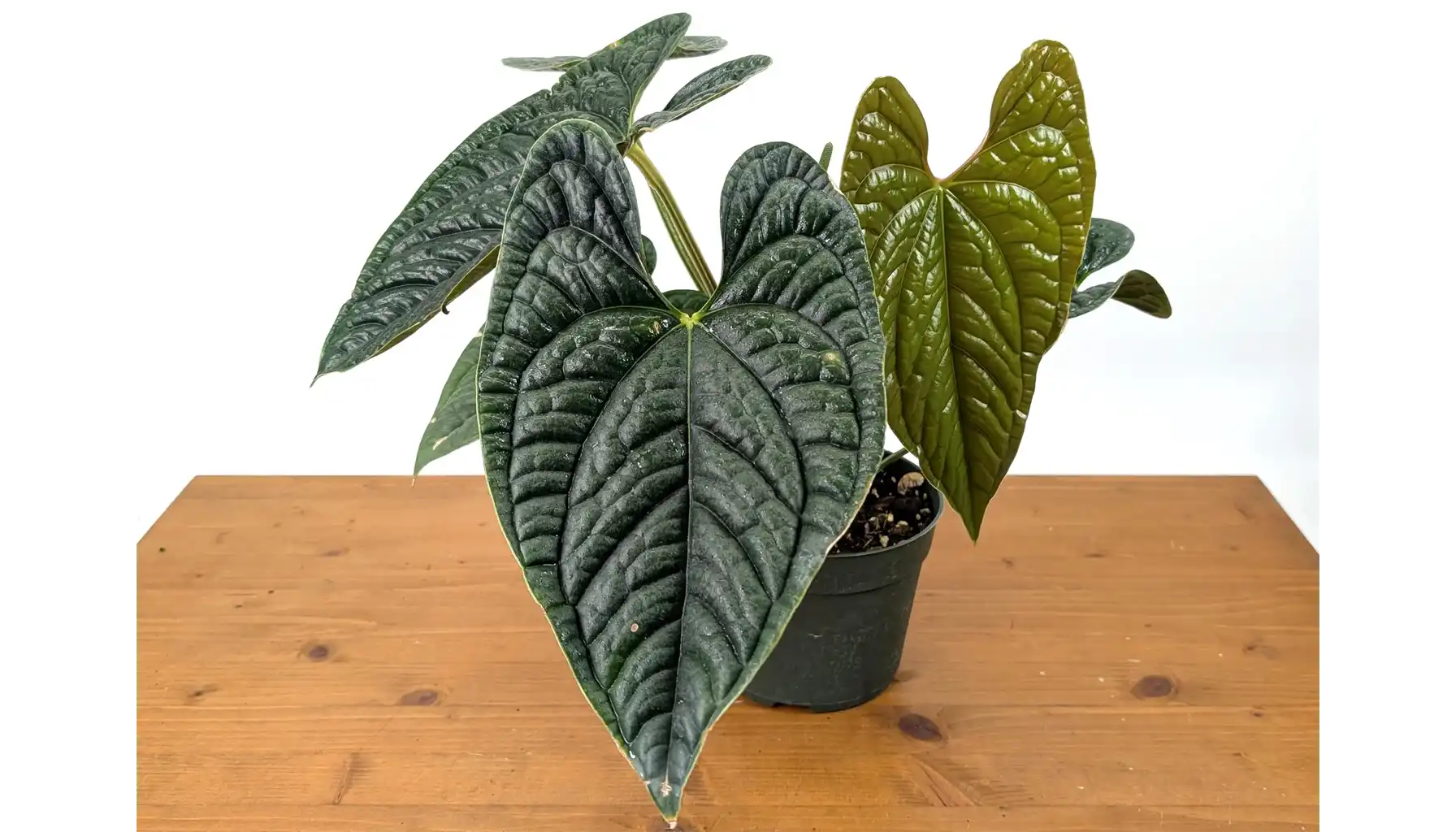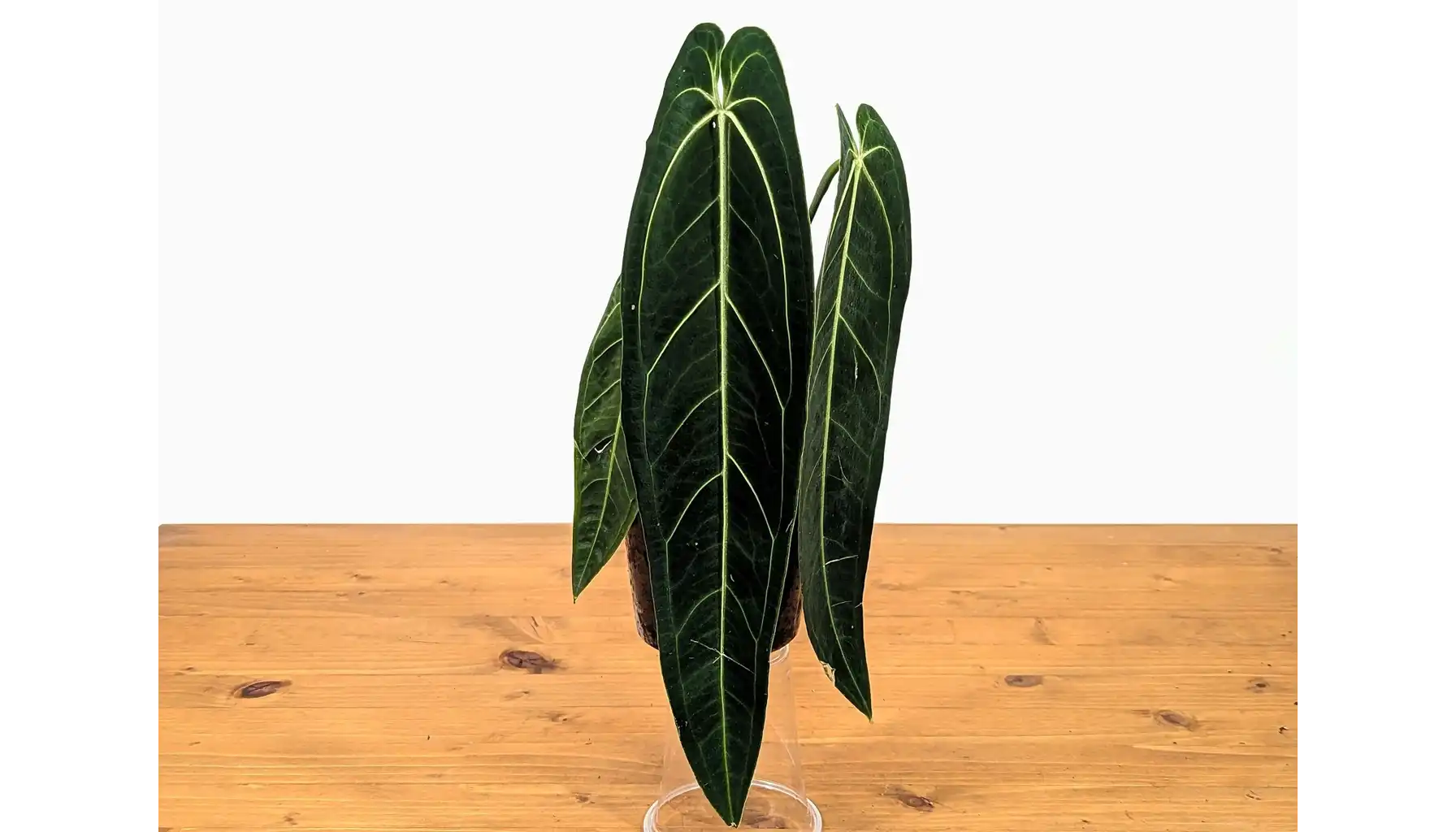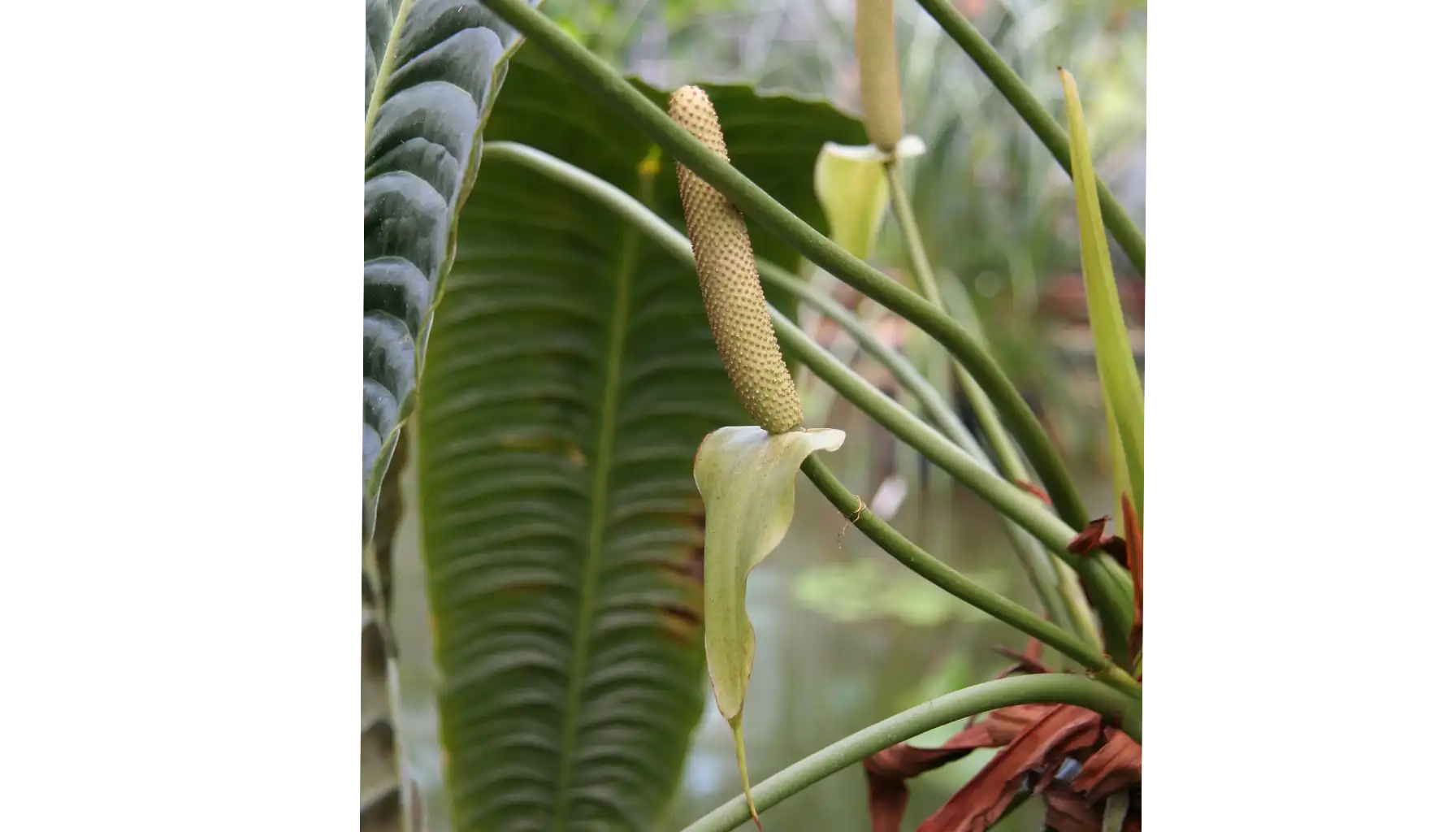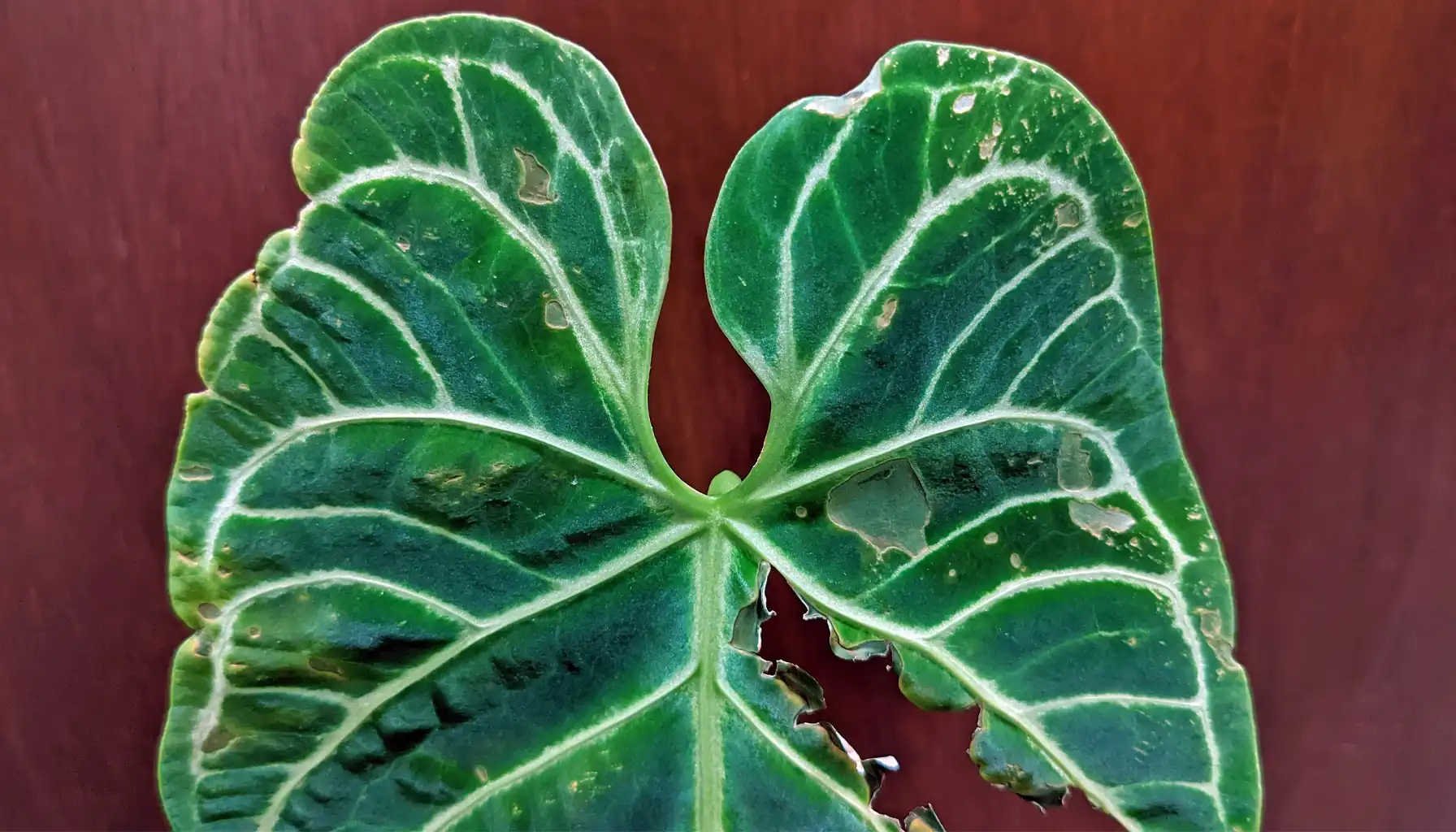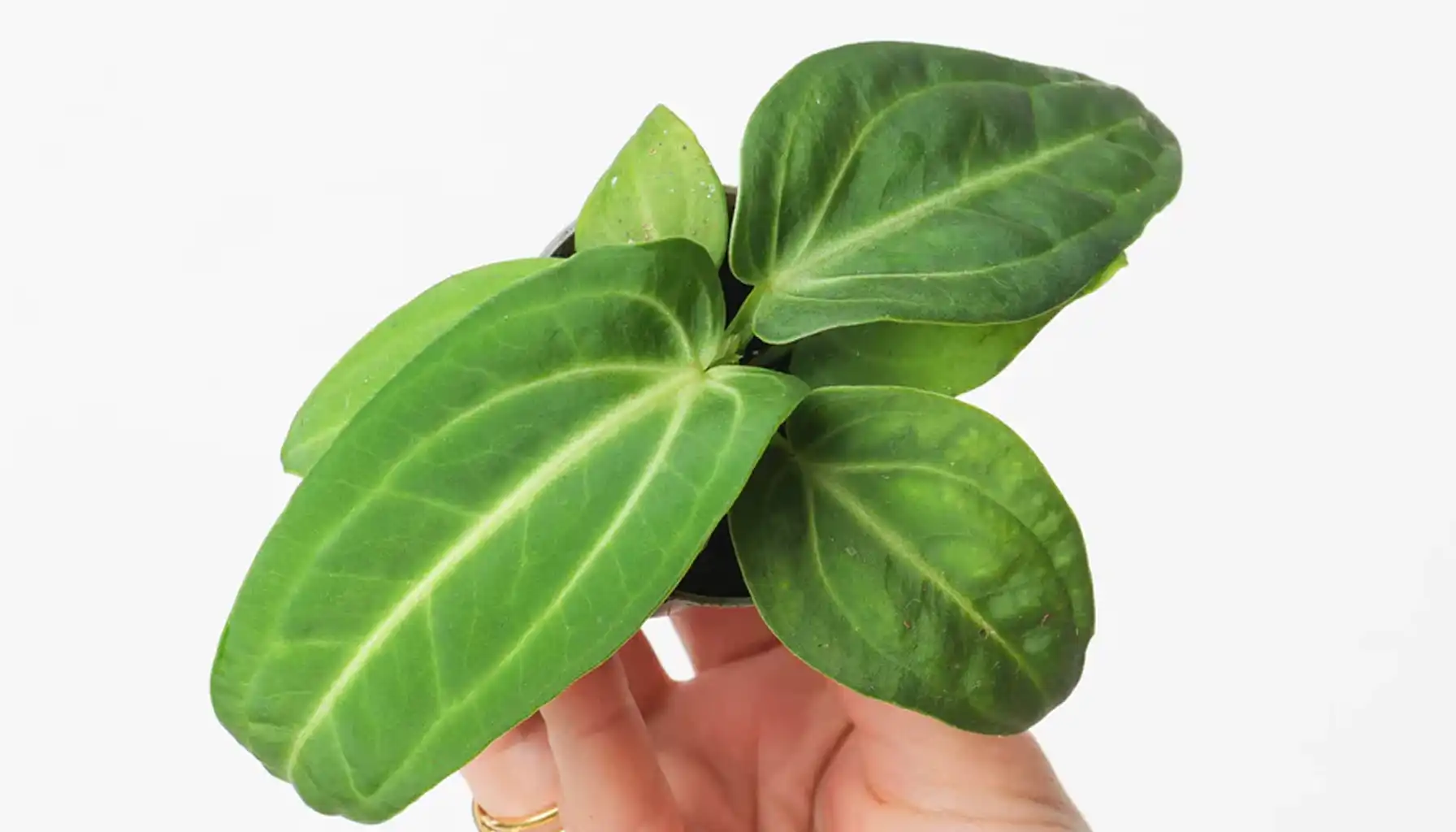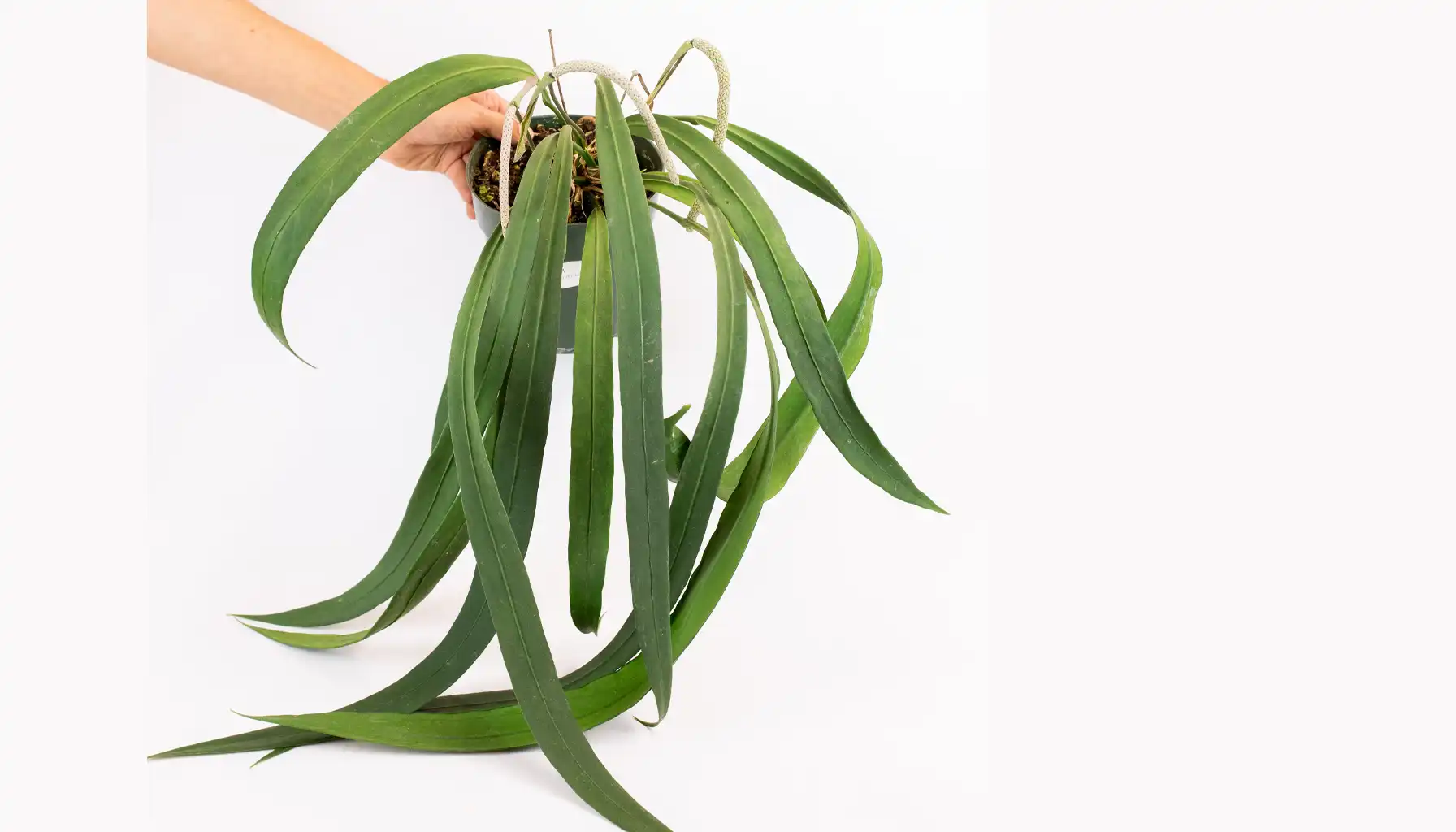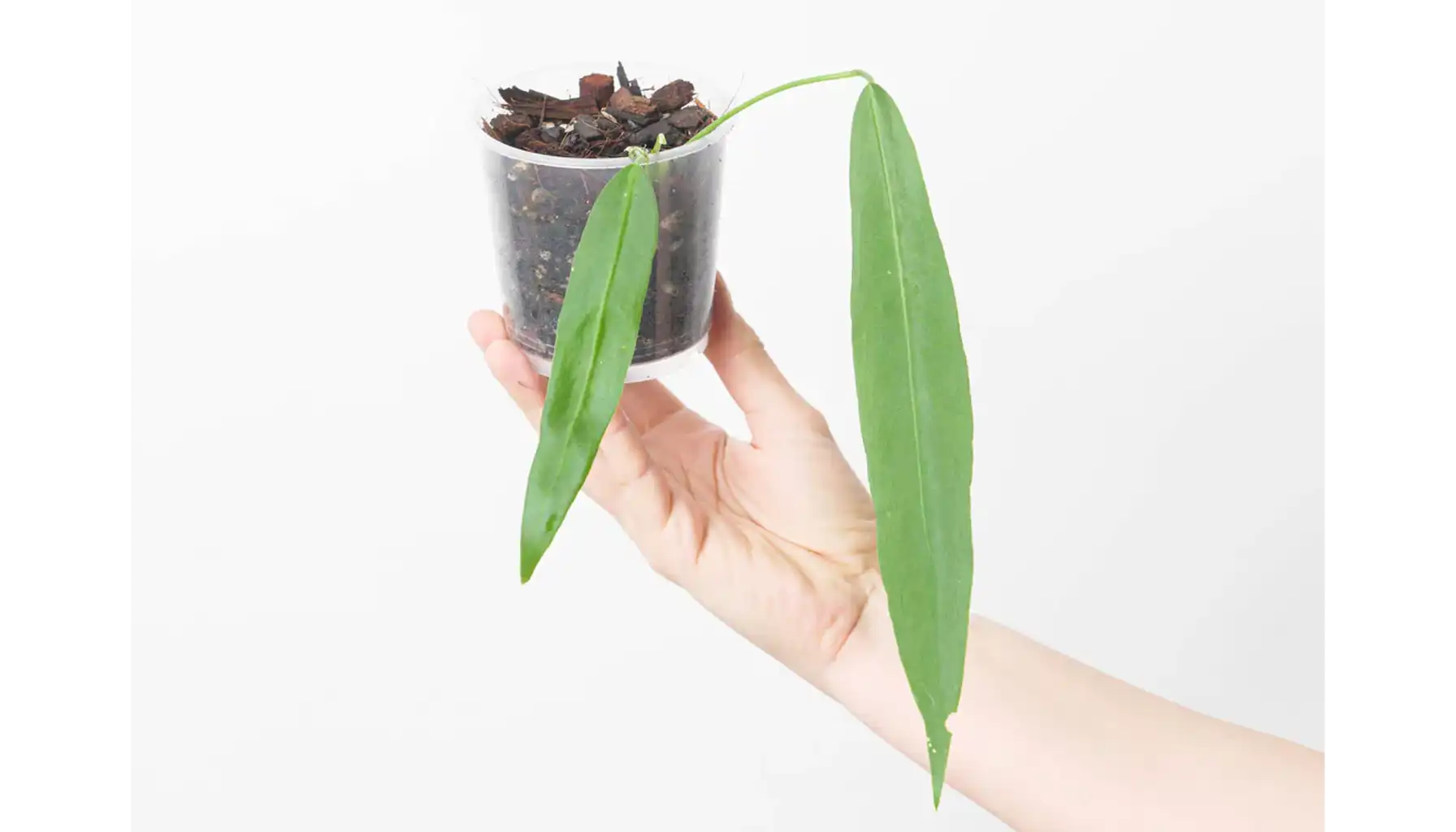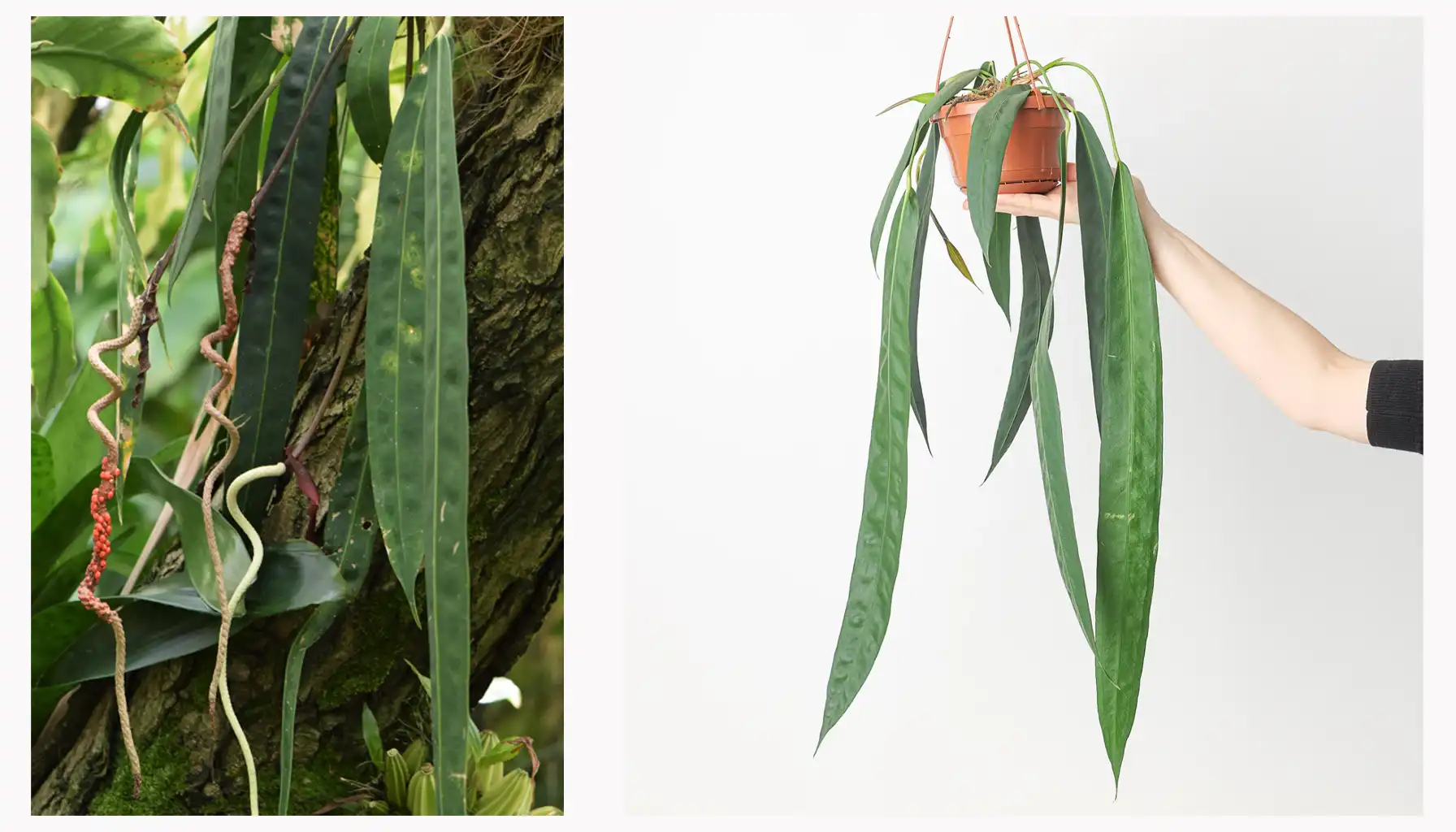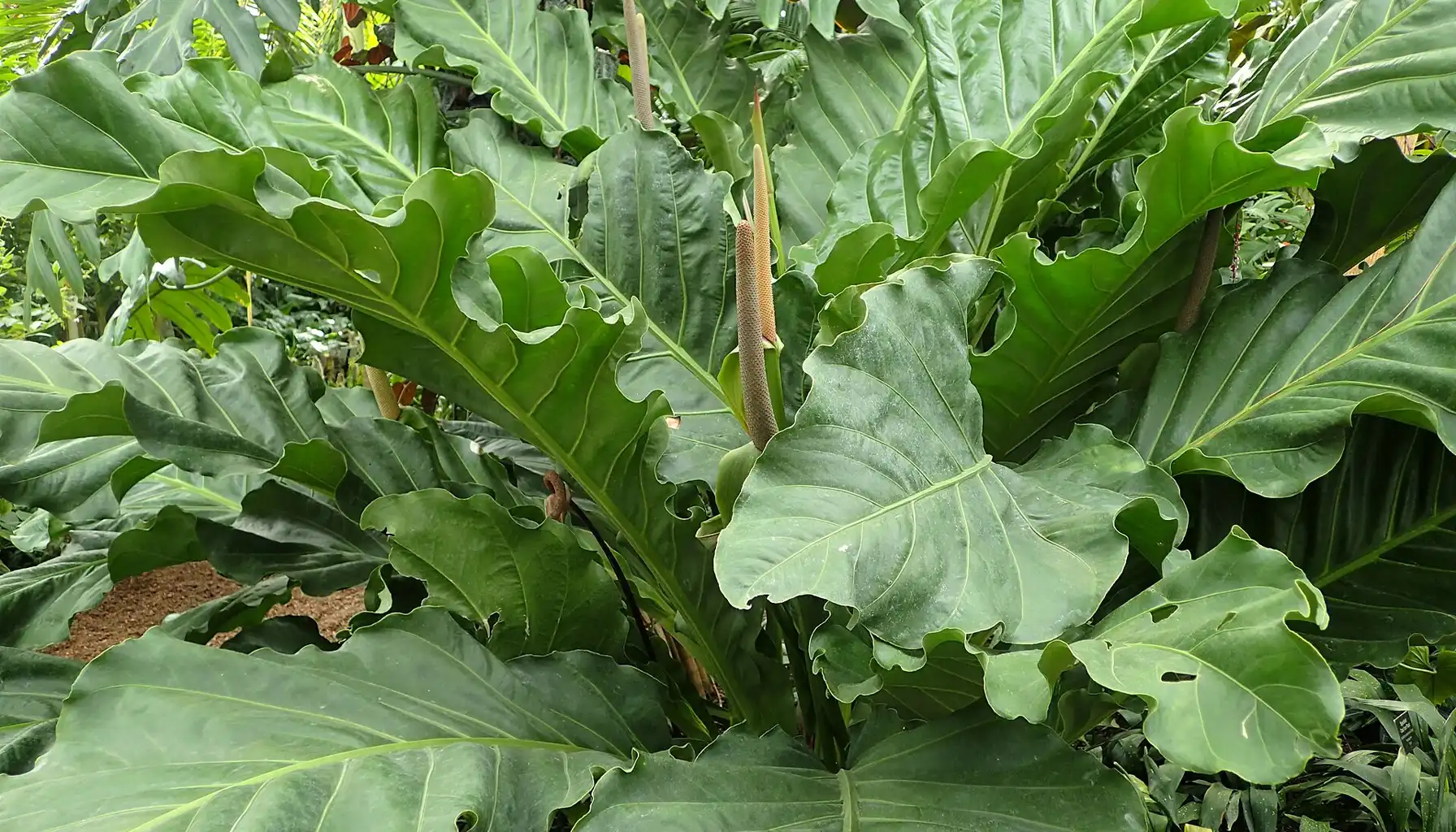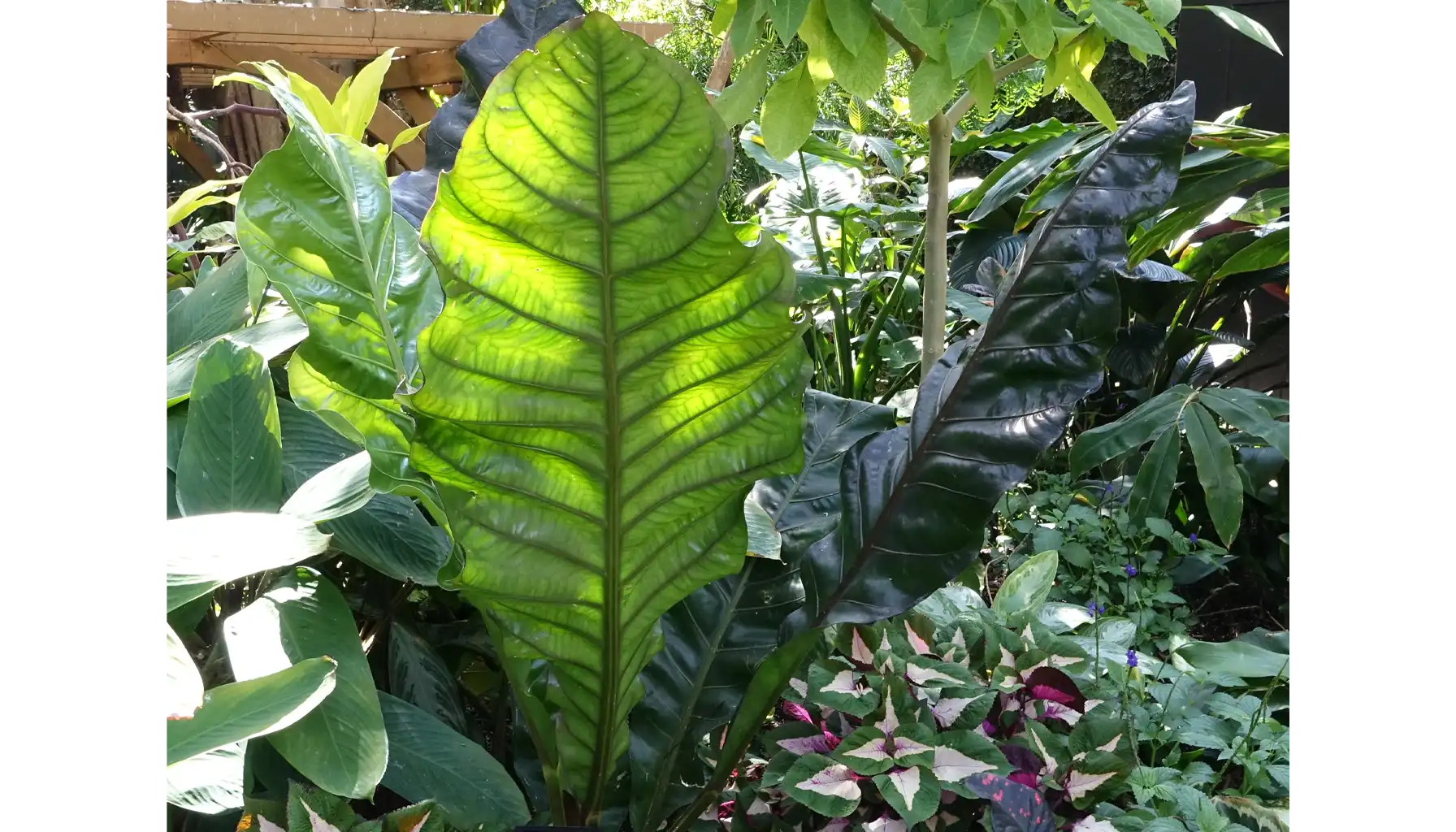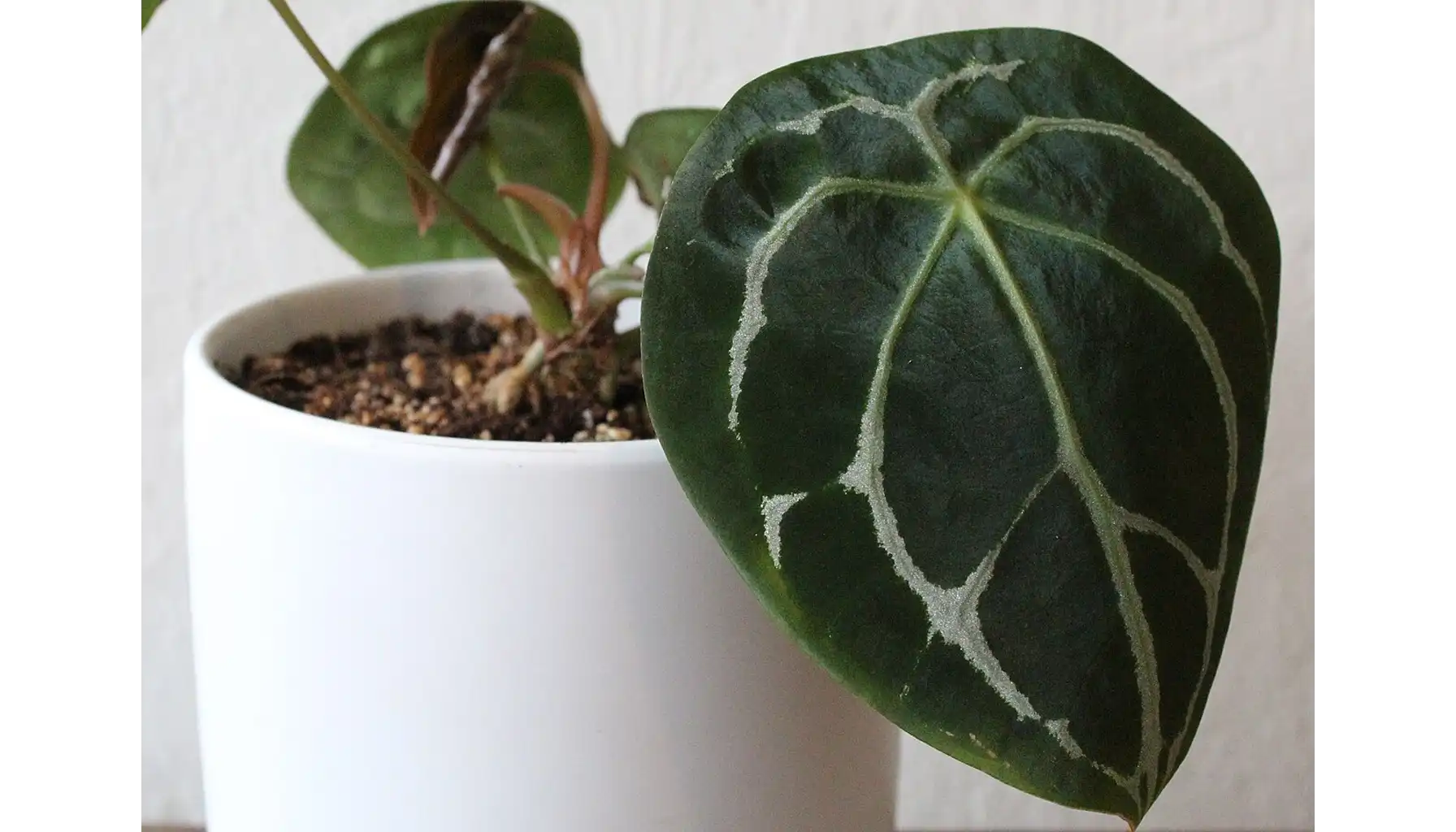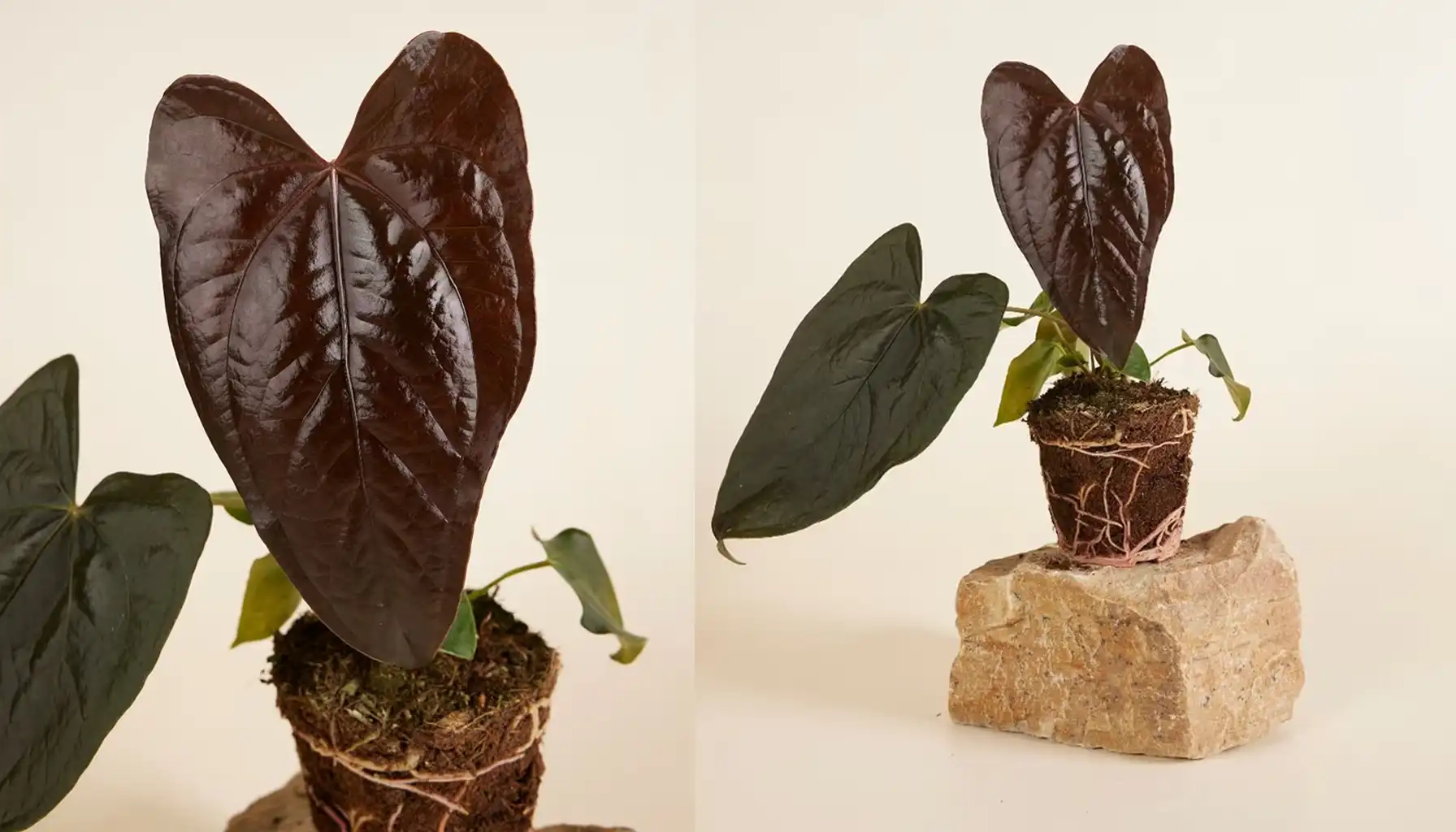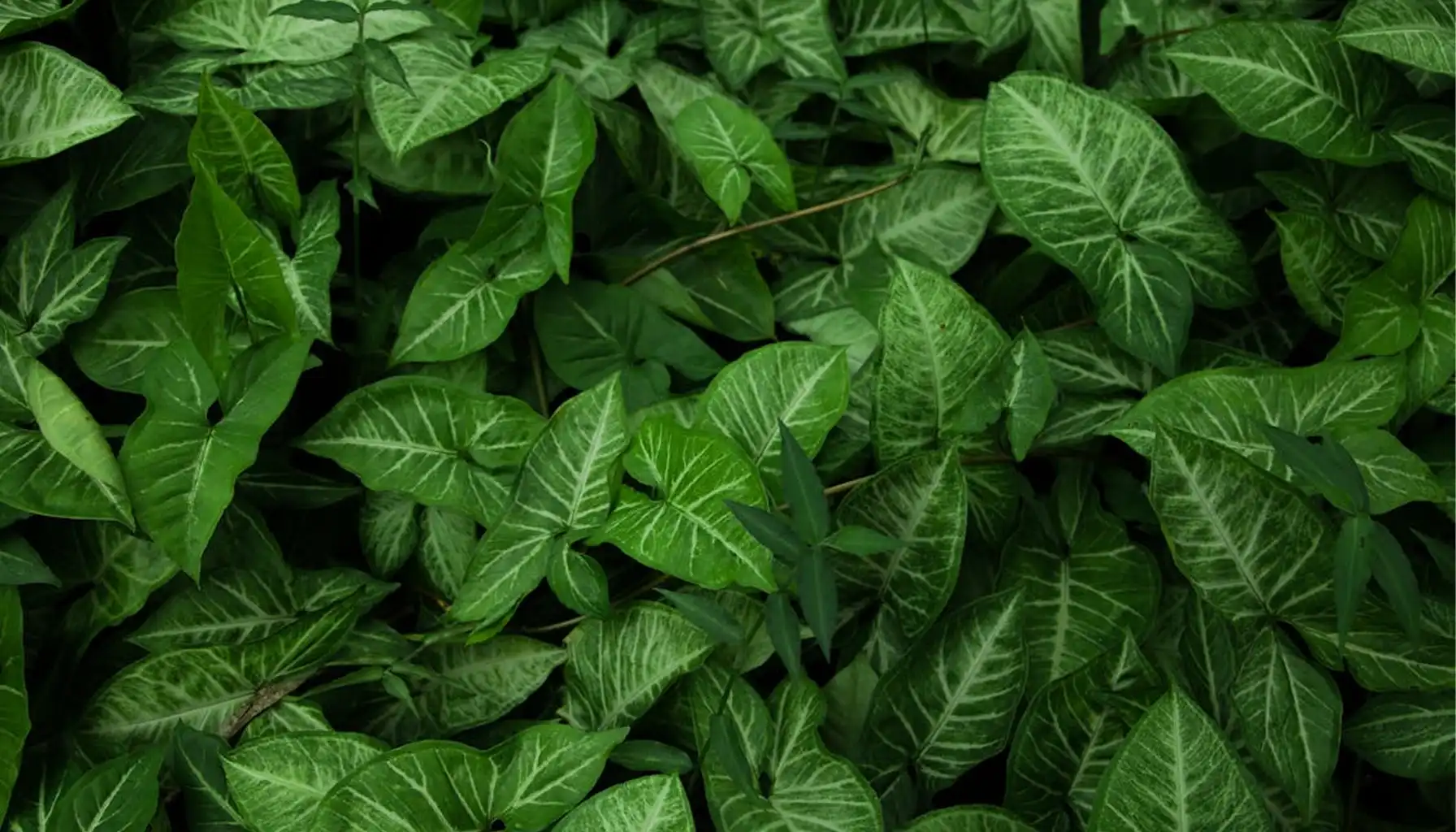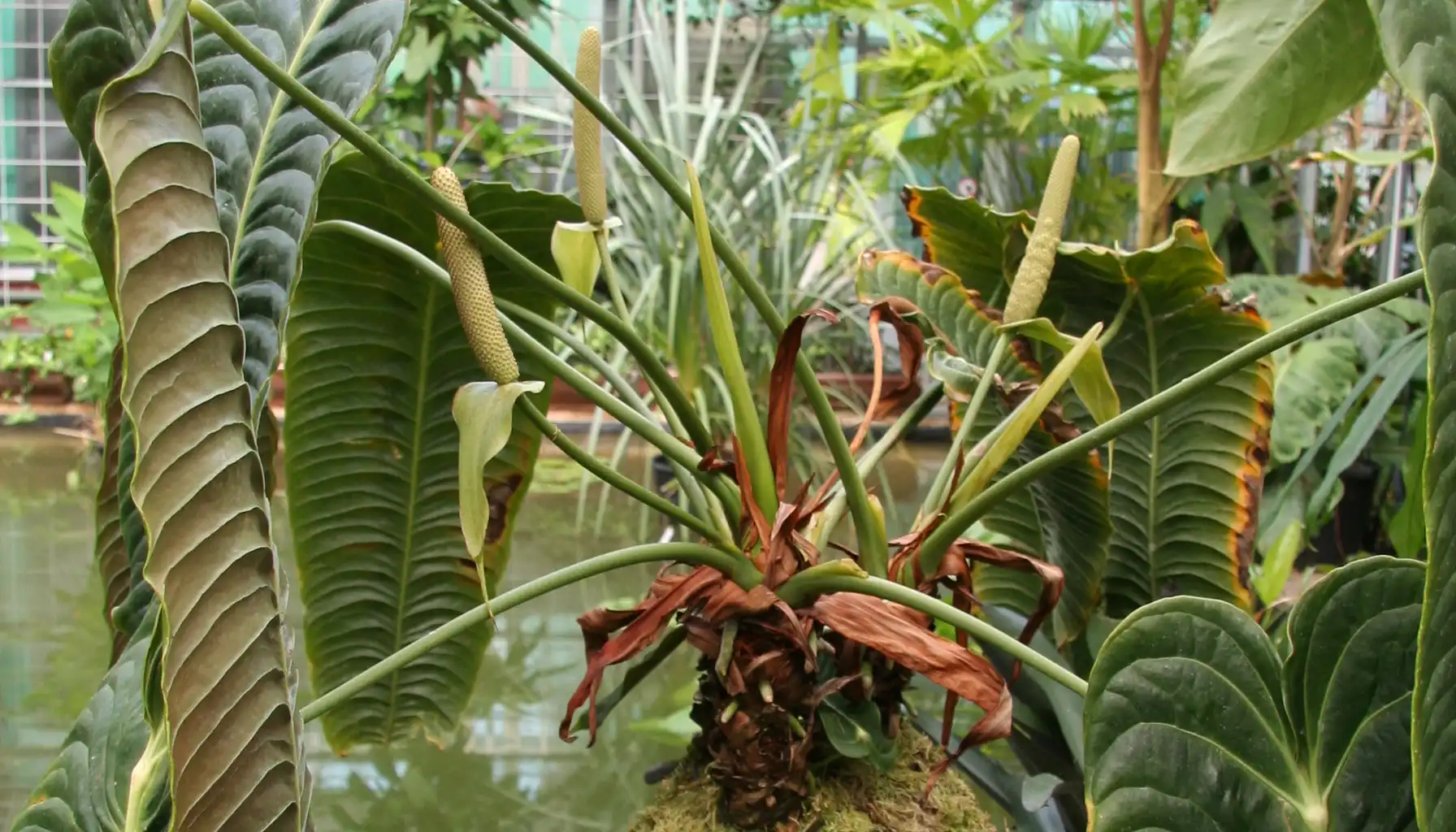All the Anthurium plants live in warm places like Central and South America, therefore, caring for them can be difficult for locations with severe frosts.
Nevertheless, you have the opportunity to study in detail all the nuances of any plant, choose a suitable option for yourself, use the plant identification app, and after a while perceive care as a hobby and not as a complicated routine.
General Rules for Anthurium Plant Care
Light and Warmth
Anthurium care includes light that is bright but not direct sunlight, because the sun in the middle of the day can burn their leaves easily, and the best place for them is near an east or west window, but plants with very dark leaves, like Anthurium luxurians or Anthurium magnificum, can stay in a darker place, while the plants that make flowers, like Anthurium andraeanum, need more light to make many flowers.
The temperature should be warm all the time, which is usually between +20∘C and +25∘C for the whole year, and many tropical plants, especially the ones from the mountains, do not like cold air, and when the temperature is less than +16∘C, the plant may stop growing or its roots can become bad and soft.
Water and Air Moisture
High air moisture is very important for Anthuriums, and most plants with big leaves, like Anthurium warocqueanum, Anthurium regale, and Anthurium veitchii, need the air to be very wet, between 60% and 80% moisture.
Because if the air is not wet enough, the leaves will look bad and become yellow on the sides, and small bugs can start living there, so it is good to use a machine that makes the air wet or keep the plants in a special small glass house.
You should give the plant water only when the top part of the soil is dry, because if you give them too much water, the roots will rot quickly, and the water must be soft, clean, and warm.
Soil and Food
The soil control for Anthuriums must be very light and have a lot of air, and it should be able to hold water but also let it go fast, which is like the soil where these plants grow on trees in nature, so a good soil mix has pieces of wood from orchid plants, small white stones called perlite, pieces of coconut, black wood pieces, and a little bit of soft dirt.
You can give the plants liquid food when they are growing fast, which is in spring and summer, but you must mix the food with more water, only 1/4 or 1/2 of the amount that the bottle says.
What about Anthurium Flowers?
People call them "flamingo flowers" because they have a colorful, shiny part called a spathe that is around a long straight part called a spadix, and the colors can be different:
Red Anthurium: This is the most popular color, and it means love
Pink Anthurium: These colors look soft and nice
White Anthurium: This color looks very clean and people often use these flowers for weddings
Plant Name | Leaf Look | Best Light | Special Features |
A. andraeanum | Shiny Spathe | Needs more light to flower | Main plant for store flowers |
A. crystallinum | Big Heart, Velvet, Silver Lines | Bright, not direct | Needs very wet air |
A. clarinervium | Small Heart, Strong lines, Velvet | Bright, not direct | Needs soil like stones |
A. magnificum | Very Big, Velvet, Square Stem | Bright, not direct | Needs a lot of space |
A. luxurians | Dark, Bumpy like leather | Bright, not direct | Needs very wet air |
A. warocqueanum | Very Long, Thin, Velvet | Bright, not direct | Needs very wet air |
A. veitchii | Very Long, Wrinkled like blinds | Bright, not direct | Needs very wet air |
A. regale | Big Heart, Velvet, Very Wide | Bright, not direct | Leaves get very big |
A. vittarifolium | Very Long, Narrow, Hanging | Bright, not direct | Grows well hanging down |
A. hookeri | Wide, Hard, Grows in a circle | Bright, not direct | Do not let water stay in the center |
A. forgetii | Round shape, Velvet, Center Stem | Bright, not direct | Rare, stem is in the middle of the leaf |
Anthurium crystallinum
This is one of the most famous velvet-leaf Anthuriums, and it has big, heart-shaped leaves that are dark green and have very clear silver or white lines that look like someone drew them on the leaf.
And new leaves are often red or brown, but they become dark over time, so this plant needs warm air and a lot of air moisture, and it does not like cold.
Anthurium clarinervium
This plant is called "Anthurium with a velvet heart," and its leaves are rounder and smaller than A. crystallinum, and they have a strong, clear line pattern, and because A. clarinervium naturally grows on rocks
Its soil must be very easy for water to run away, almost like stones, so that the water does not stay around the neck of the plant.
Anthurium magnificum
The name of this plant means "great," and it is a wonderful Anthurium with very big, dark green leaves that are very velvety, but the main way to know it from A. crystallinum is that its stems are square with clear corners.
The stems of A. crystallinum are round, and the leaves can become very big, so the plant needs a lot of space and very wet air to grow well.
Anthurium papillilaminum
This amazing plant has long, thin, dark green-black leaves that are velvety, and its name comes from the Latin word papilla meaning a small bump, which describes the leaf's feeling, and it is okay with slightly less air moisture than A. warocqueanum, but it needs soil that is perfectly light and airy.
Anthurium luxurians
This is a very special Anthurium because its leaves are not only velvety but also hard like leather and very dark, almost black, and they have an unusual, bumpy, wrinkled surface that looks like many small hills and valleys, which makes the leaf very strong.
But it needs very high air moisture because it comes from the very wet forests in Ecuador.
Anthurium warocqueanum
Queen Anthurium plant is known for its very long, thin, hanging leaves that can be two meters long in nature, and the leaves are deep green and velvety with clear white lines, but Anthurium warocqueanum is one of the hardest plants to grow because it needs air moisture of 75% or more.
And you must never give it too much water, and because the leaves are long, it often needs a tall stick to help it stand up.
LifeHack: If it's difficult for you to remember which specific type of plant you have, and what's wrong with your plant → take a picture of the leaves/flowers/plant as a whole → upload to the AI Plant Finder app → find out all the tips.
Anthurium veitchii
The King Anthurium is different from the queen because its surface is very bumpy and wrinkled, and its leaves are also very long and hanging, but they have strong wrinkles that look like window blinds, which makes the leaf look special in three dimensions.
And it needs a place with bright light but no direct sun, and it also needs air that is very wet.
Anthurium regale
The "royal" Anthurium is like A. warocqueanum, but its leaves are wider, heart-shaped, and can grow very big, more than one meter wide in good conditions, and its dark green velvet surface with light lines makes it look very important.
So like the other royal types, you must take care of the air moisture, the warmth, and make sure the roots get enough air.
Anthurium villenaorum
This plant from Peru is famous for its wide, dull green leaves that have strong raised lines, which makes the leaf look like a woven basket, and people think it is easier to care for at home than A. warocqueanum.
But you still need to watch the air moisture so the leaves do not become bad.
Anthurium vittarifolium
This plant has very narrow, long, hanging leaves that look like ribbons and can be 60-80 centimeters long, and it grows on trees.
So it grows very well in pots that hang down or on tall sticks that look like trees, and the soil must be very light and dry quickly.
Anthurium pallidiflorum
This plant has long, stiff, hanging leaves with a nice surface, and the special thing about it is the light green or yellow color of its flower part, which is why it has this name.
And it is usually easier to care for at home and is okay with small changes in air moisture than the velvet types.
Anthurium wendlingeri
This is a special and unusual plant because its leaves are simple and green, but its flower part is long and curly, like a screw or a braid, which makes people want to collect it, and it likes a place with a little bit of shade and wet air.
Anthurium hookeri
This plant grows on the ground or on trees, and it has wide, hard, dark green leaves that grow in a circle and look like a nest, which helps the plant to collect falling leaves and water to get food.
So it is quite easy to care for, but the soil must let water go away fast so that water does not stay inside the plant's nest.
Anthurium superbum
This plant is like A. hookeri, but its leaves are harder, shinier, and have clear, strong bumps on the sides and a very clear line in the middle.
So it looks more like a sculpture or made of plastic, and it also grows in a round nest shape.
Anthurium forgetii
This is a very rare and wanted plant because its leaves have a special round shape, which means the stem does not attach to the side of the leaf but in the center, making the leaf perfectly round or oval, and the leaf has a deep velvet color with clear white lines.
So it is easy to see that it is A. forgetii, and you must care for it like the other velvet plants, needing high air moisture and warmth.
Special Names and Types
Many names that you can see in stores are names for plants that people made by mixing two types (hybrids) or names used for selling:
Emma Anthurium: This is often sales name for very pretty types or hybrids of A. crystallinum and A. magnificum, which people choose because they have a special leaf shape, color, or lines, and Anthurium Queen of Hearts is an example of a mixed plant with very big and deep leaf parts.
Anthurium Delta Force: This is most likely a name for a mixed type of plant that people made through growing new plants, and it has special leaf features, like a very sharp point or a special shape, so these mixed plants are often stronger and easier to keep in a house than the natural types.
Are Anthuriums Toxic to Cats?
Yes, Anthuriums, like most plants in the Araceae family, are poisonous for pets like cats and dogs, and also for people, because all parts of the plant have small, sharp crystals in them, which are called calcium oxalate.
If an animal eats or chews toxic plants, the cause:
Pain: A strong burning and pain in the mouth, tongue, throat, and food pipe.
Bad Signs: Swelling which can make breathing hard, much saliva coming out, vomiting, and problems with eating.
Therefore, you must keep all Anthuriums in a place where cats and other pets cannot reach them, and if you think your pet ate a part of the plant, you must go to the vet quickly.
Related AI Plant Finder Posts
